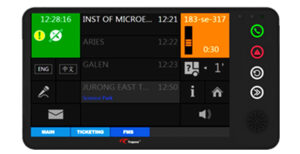Resource Hub
The Evolution of the IPT2-10 (MADT)
The Evolution of the IPT2-10 (MADT): A Journey of Innovation and User-Centric Design
The story of the IPT2-10, or the Multi-functional Advanced Driver Terminal (MADT), is one of collaboration, iteration, and a relentless focus on improving the bus captain’s experience. What began as a bold vision to consolidate ticketing and Fleet Management System (FMS) functionalities into a single, feature-rich unit has now evolved into a sleek, intuitive device poised to transform Singapore’s public transport operations.
From Concept to Reality: The Early Days
The MADT’s journey started with an ambitious goal: to create a unified terminal that combined 13 physical buttons with a large touchscreen, merging ticketing and FMS controls into one streamlined interface. The Land Transport Authority (LTA) aimed to simplify the bus captain’s workflow, reducing clutter and enhancing efficiency. Early prototypes were robust, packing in as much functionality as possible, but user feedback revealed an unexpected challenge.
“The unit was too big,” shared one bus captain during trials. “It took up too much space in the cabin and felt overwhelming to navigate during peak hours.”
Listening and Refining: The Redesign
Armed with this feedback, the design team went back to the drawing board. The new goal was clear: minimise the footprint, maximise the 10-inch touchscreen’s potential. Several prototypes were developed, each iterating on button placement, screen responsiveness, and ergonomics. The final design emerged as a harmonious balance, retaining only four critical physical buttons (Request to Talk, Priority Request to Talk, Tab Switch, and Reset) while leveraging the touchscreen for dynamic, context-aware controls.

Key technical innovations included:
-
- Tab-Based Navigation: Allowing seamless switching between FMS, ticketing, and other functions, with icons designed for quick recognition.
- Dynamic Button Mapping: Physical buttons adapt their functions based on the active tab, ensuring flexibility without clutter.
- Delayed Sleep Mode: Ensuring the unit stays operational post-ignition for critical tasks, with a fallback timer to conserve power.
Overcoming Technical Hurdles
One of the standout challenges was ensuring robust performance under real-world conditions. The MADT’s dual watchdog system (software and hardware) guarantees reliability, automatically rebooting the device if issues arise. Meanwhile, the A/B update architecture ensures seamless over-the-air (OTA) software upgrades, with GPG-signed packages for security.
Security was another critical focus. The team implemented HMAC-based one-time passwords (HOTP) to protect sensitive ITxPT commands, adhering to RFC 4226 standards. “It’s about balancing security with practicality,” explained the product team. “We needed a solution that worked within ITxPT’s framework while safeguarding against unauthorised access.”
The Road Ahead: Certification and Deployment
Today, the first production units are undergoing rigorous compliance certification, with 18 of 26 tests already completed. Preliminary reports are promising, paving the way for non-revenue trials in Singapore this June.
“This is more than just a hardware upgrade,” noted Johannes Rogg, Product Manager at Trapeze. “The MADT is the bridge to Singapore’s next-generation Networked Fleet Management System (NFMS), set to go live in October 2026. It’s about empowering bus captains with smarter tools while laying the groundwork for future innovations.”
A Milestone Moment
As the MADT begins its journey into Singapore’s buses, it stands as a testament to the power of user feedback and iterative design. From a bulky prototype to a refined, purpose-built terminal, the IPT2-10 embodies the future of public transport—one where technology serves people, not the other way around.
Stay tuned as the MADT hits the roads, ushering in a new era of connected, efficient bus operations. The best is yet to come.
Mode of Transport
Public Transport Authorities, Bus
Solutions
Intelligent Transport Systems
Meet the author
Trapeze Group